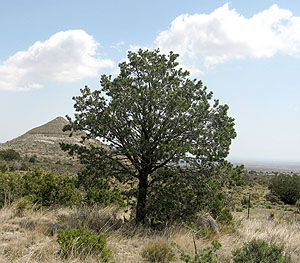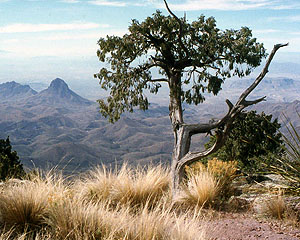New Mexico Piñon, Mexican Piñon, Papershell Piñon
Pinus edulis Engelm.; Pinus cembroides Zucc.; Pinus remota (Little) Bailey & Hawkesworth
Three Trans-Pecos piñon species were used for food and other needs by native peoples: New Mexico piñon, Mexican piñon, and the papershell piñon. All are small to medium evergreen trees with relatively short needles. Mexican piñon grows mostly on soil from igneous substrates and papershell piñon on soil from limestone parent material. In the Trans-Pecos Mexican piñon grows at higher eleveations and papershell piñon at somewhat lower elevations in the central and eastern half of the region. New Mexico piñon grows mostly in the western Trans-Pecos, and is the state tree of New Mexico (Powell 1998). Although piñon is known for its edible seeds, the plant had many other uses including medicinal and as a material for fashioning tools.
Archeology. Piñon is seldom recovered from archeological sites. In the eastern Trans-Pecos, however, two mortars made of piñon wood have been found in caves or crevices in Terrell County (Collins and Hester 1968; Prewitt 1981). One of the mortars contained prickly pear seeds, attesting to its use for pulverizing the fruit (Collins and Hester 1968).
Food. The Mescalero Apache valued the piñon nut or seed, but they did not rely on it, for the crops were too unpredictable. The harvest fluctuated due to variability in the local tree populations and to long-term weather conditions. However, once parched, the piñon nut was easily stored so they collected large quantities whenever possible. Nuts were usually collected in October, but they could persist on the trees throughout the winter if the crop was bountiful (Basehart 1960).
The Mescalero collected the nuts in family or in larger informal groups, usually comprised mostly of women; no claim was made to specific stands of trees. Usually the nuts were gathered from the ground, but sometimes the nuts were shaken from the tree onto animal hides. Although up to 25 pounds of nuts could be collected by a single woman, a pack rat midden could yield 50 to 100 pounds (Basehart 1960). The Zuni gathered large quantities of nuts, parched them, and stored them for winter use (Stevenson 1915).
Processing piñon nuts was relatively simple; they were parched on hot rocks or coals and stored in the shells. The Mescalero ground them sometimes leaving them in the shell. The powder or meal was mixed with other foods, including banana yucca (datil), mesquite meal, or agave/sotol cakes. The nuts were stored in containers (Basehart 1960; Buskirk 1986). In addition to storing the whole nuts, the Ramah Navajo ground them, fashioned them into sun-dried cakes, and stored the cakes (Vestal 1952).
Ceremonial. The Mescalero gathered pollen in the spring and used it as a substitute for cattail pollen. Piñon nuts were considered an important food for girl’s puberty rites (Basehart 1960). The Ramah Navajo used branches from trees struck by lightning in the Evilway ceremony (Vestal 1952).
Medicinal and hygienic. Colds were treated by inhaling smoke from the needles or from burning resin (Basehart 1960; Vestal 1952). A poultice of masticated buds were applied to burns by the Ramah Navajo. They also used a concoction of needles as an emetic for ceremonies (Vestal 1952). In an application reminiscent of the bikini wax, heated resin was applied to facial hair to facilitate its removal (Buskirk 1986). I trust that the temperature of the resin was carefully controlled.
The Zuni used the piñon for several medicinal applications. Consuming the needles, or consuming an infusion of the needles, promoted profuse sweating. The resin was ground and applied to lanced skin infections as an antiseptic.
Tools, implements, building construction, and dye. The wood was used for cradle boards and weaving implements, and the resin for waterproofing basketry. (Basehart 1960; Vestal 1952). The resin was also used to dye wool by the Ramah Navajo. They used the logs and branches in the construction of hogans, fences, and sweathouses. Of course, the wood was used for fuel (Vestal 1952).
References
Basehart, Harry
1960 Mescalero Apache Subsistence Patterns and Socio-Political Organization. The University of New Mexico Mescalero-Chiricahua Land Claims Project Contract Research #290-154. University of New Mexico. Albuquerque.
Buskirk, Winfred
1986 The Western Apache: Living with the Land Before 1950. University of Oklahoma Press, Norman.
Collins, Michael B. and Thomas R. Hester
1968 A Wooden Mortar and Pestle From Val Verde County, Texas. Texas Archeological Society 39:1-8.
Powell, A. Michael
1998 Trees and Shrubs of the Trans-Pecos and Adjacent Areas. University of Texas Press. Austin.
Prewitt, Elton R.
1981 A Wooden Mortar from the Stockton Plateau of Texas. Journal of Field Archaeology 8:111-117.
Stevenson, Matilda C.
1915 Ethnobotany of the Zuñi Indians. In Thirtieth Annual Report of the Bureau of American Ethnology. [1908-1909], pp. 35-103. Washington, D.C.
Vestal, Paul
1952 Ethnobotany of the Ramah Navaho. Papers of the Peabody Museum of American Archaeology and Ethnology 40 (4). Harvard University. Boston.

|

|
